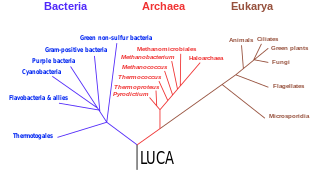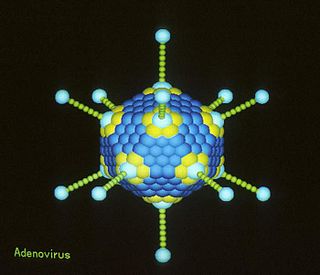Related Research Articles
Common descent is a concept in evolutionary biology applicable when one species is the ancestor of two or more species later in time. According to modern evolutionary biology, all living beings could be descendants of a unique ancestor commonly referred to as the last universal common ancestor (LUCA) of all life on Earth.

Nanoarchaeum equitans is a species of marine archaea that was discovered in 2002 in a hydrothermal vent off the coast of Iceland on the Kolbeinsey Ridge by Karl Stetter. It has been proposed as the first species in a new phylum, and is the only species within the genus Nanoarchaeum. Strains of this microbe were also found on the Sub-polar Mid Oceanic Ridge, and in the Obsidian Pool in Yellowstone National Park. Since it grows in temperatures approaching boiling, at about 80 °C (176 °F), it is considered to be a thermophile. It grows best in environments with a pH of 6, and a salinity concentration of 2%. Nanoarchaeum appears to be an obligate symbiont on the archaeon Ignicoccus; it must be in contact with the host organism to survive. Nanoarchaeum equitans cannot synthesize lipids but obtains them from its host. Its cells are only 400 nm in diameter, making it the smallest known living organism, and the smallest known archaeon.

The last universal common ancestor (LUCA) is the hypothesized common ancestral cell from which the three domains of life, the Bacteria, the Archaea, and the Eukarya originated. It is suggested to have been a "cellular organism that had a lipid bilayer and used DNA, RNA, and protein". The LUCA has also been defined as "a hypothetical organism ancestral to all three domains". The LUCA is the point or stage at which the three domains of life diverged from preexisting forms of life. The nature of this point or stage of divergence remains a topic of research.
A replicon is a region of an organism's genome that is independently replicated from a single origin of replication. A bacterial chromosome contains a single origin, and therefore the whole bacterial chromosome is a replicon. The chromosomes of archaea and eukaryotes can have multiple origins of replication, and so their chromosomes may consist of several replicons. The concept of the replicon was formulated in 1963 by François Jacob, Sydney Brenner, and Jacques Cuzin as a part of their replicon model for replication initiation. According to the replicon model, two components control replication initiation: the replicator and the initiator. The replicator is the entire DNA sequence required to direct the initiation of DNA replication. The initiator is the protein that recognizes the replicator and activates replication initiation.
Viral eukaryogenesis is the hypothesis that the cell nucleus of eukaryotic life forms evolved from a large DNA virus in a form of endosymbiosis within a methanogenic archaeon or a bacterium. The virus later evolved into the eukaryotic nucleus by acquiring genes from the host genome and eventually usurping its role. The hypothesis was first proposed by Philip Bell in 2001 and was further popularized with the discovery of large, complex DNA viruses that are capable of protein biosynthesis.

Non-cellular life, also known as acellular life, is life that exists without a cellular structure for at least part of its life cycle. Historically, most definitions of life postulated that an organism must be composed of one or more cells, but this is for some no longer considered necessary, and modern criteria allow for forms of life based on other structural arrangements.

Neomura is a proposed clade of biological life composed of the two domains Archaea and Eukaryota, coined by Thomas Cavalier-Smith in 2002. Its name reflects the hypothesis that both archaea and eukaryotes evolved out of the domain Bacteria, and one of the major changes was the replacement of the bacterial peptidoglycan cell walls with other glycoproteins.

Nitrosopumilus maritimus is an extremely common archaeon living in seawater. It is the first member of the Group 1a Nitrososphaerota to be isolated in pure culture. Gene sequences suggest that the Group 1a Nitrososphaerota are ubiquitous with the oligotrophic surface ocean and can be found in most non-coastal marine waters around the planet. It is one of the smallest living organisms at 0.2 micrometers in diameter. Cells in the species N. maritimus are shaped like peanuts and can be found both as individuals and in loose aggregates. They oxidize ammonia to nitrite and members of N. maritimus can oxidize ammonia at levels as low as 10 nanomolar, near the limit to sustain its life. Archaea in the species N. maritimus live in oxygen-depleted habitats. Oxygen needed for ammonia oxidation might be produced by novel pathway which generates oxygen and dinitrogen. N. maritimus is thus among organisms which are able to produce oxygen in dark.

Gustavo Caetano-Anollés is Professor of Bioinformatics in the Department of Crop Sciences, University of Illinois at Urbana-Champaign. He is an expert in the field of evolutionary and comparative genomics.

A prokaryote is a single-cell organism whose cell lacks a nucleus and other membrane-bound organelles. The word prokaryote comes from the Ancient Greek πρό 'before' and κάρυον 'nut, kernel'. In the two-empire system arising from the work of Édouard Chatton, prokaryotes were classified within the empire Prokaryota. But in the three-domain system, based upon molecular analysis, prokaryotes are divided into two domains: Bacteria and Archaea. Organisms with nuclei are placed in a third domain, Eukaryota.

Archaea is a domain of single-celled organisms. These microorganisms lack cell nuclei and are therefore prokaryotes. Archaea were initially classified as bacteria, receiving the name archaebacteria, but this term has fallen out of use.

The Nitrososphaerota are a phylum of the Archaea proposed in 2008 after the genome of Cenarchaeum symbiosum was sequenced and found to differ significantly from other members of the hyperthermophilic phylum Thermoproteota. Three described species in addition to C. symbiosum are Nitrosopumilus maritimus, Nitrososphaera viennensis, and Nitrososphaera gargensis. The phylum was proposed in 2008 based on phylogenetic data, such as the sequences of these organisms' ribosomal RNA genes, and the presence of a form of type I topoisomerase that was previously thought to be unique to the eukaryotes. This assignment was confirmed by further analysis published in 2010 that examined the genomes of the ammonia-oxidizing archaea Nitrosopumilus maritimus and Nitrososphaera gargensis, concluding that these species form a distinct lineage that includes Cenarchaeum symbiosum. The lipid crenarchaeol has been found only in Nitrososphaerota, making it a potential biomarker for the phylum. Most organisms of this lineage thus far identified are chemolithoautotrophic ammonia-oxidizers and may play important roles in biogeochemical cycles, such as the nitrogen cycle and the carbon cycle. Metagenomic sequencing indicates that they constitute ~1% of the sea surface metagenome across many sites.

The eocyte hypothesis in evolutionary biology proposes that the eukaryotes originated from a group of prokaryotes called eocytes. After his team at the University of California, Los Angeles discovered eocytes in 1984, James A. Lake formulated the hypothesis as "eocyte tree" that proposed eukaryotes as part of archaea. Lake hypothesised the tree of life as having only two primary branches: prokaryotes, which include Bacteria and Archaea, and karyotes, that comprise Eukaryotes and eocytes. Parts of this early hypothesis were revived in a newer two-domain system of biological classification which named the primary domains as Archaea and Bacteria.

David Prangishvili is a virologist, Professor at the Pasteur Institute of Paris, and foremost authority on viruses infecting Archaea.
The "Aigarchaeota" are a proposed archaeal phylum of which the main representative is Caldiarchaeum subterraneum. It is not yet clear if this represents a new phylum or a Nitrososphaerota order, since the genome of Caldiarchaeum subterraneum encodes several Nitrososphaerota-like features. The name "Aigarchaeota" comes from the Greek αυγή, avgí, meaning "dawn" or "aurora", for the intermediate features of hyperthermophilic and mesophilic life during the evolution of its lineage.
"Candidatus Thorarchaeota", or simply Thorarchaeota, is a phylum within the superphylum Asgard archaea. The Asgard superphylum represents the closest prokaryotic relatives of eukaryotes. Since there is such a close relation between the two different domains, it provides further evidence to the two-domain tree of life theory which states that eukaryotes branched from the archaeal domain. Asgard archaea are single cell marine microbes that contain branch like appendages and have genes that are similar to eukarya. The asgard archaea superphylum is composed of Thorarchaeota, Lokiarchaeota, Odinarchaeota, and Heimdallarchaeota. Thorarchaeota were first identified from the sulfate-methane transition zone in tidewater sediments. Thorarcheota are widely distributed in marine and freshwater sediments.

Darwinian threshold or Darwinian transition is a term introduced by Carl Woese to describe a transition period during the evolution of the first cells when genetic transmission moves from a predominantly horizontal mode to a vertical mode. The process starts when the ancestors of the Last Universal Common Ancestor become refractory to horizontal gene transfer (HGT) and become individual entities with vertical heredity upon which natural selection is effective. After this transition, life is characterized by genealogies that have a modern tree-like phylogeny.

The two-domain system is a biological classification by which all organisms in the tree of life are classified into two big domains, Bacteria and Archaea. It emerged from development of knowledge of archaea diversity and challenges to the widely accepted three-domain system that defines life into Bacteria, Archaea, and Eukarya. It was preceded by the eocyte hypothesis of James A. Lake in the 1980s, which was largely superseded by the three-domain system, due to evidence at the time. Better understanding of archaea, especially of their roles in the origin of eukaryotes through symbiogenesis with bacteria, led to the revival of the eocyte hypothesis in the 2000s. The two-domain system became more widely accepted after the discovery of a large group (superphylum) of archaea called Asgard in 2017, which evidence suggests to be the evolutionary root of eukaryotes, implying that eukaryotes are members of the domain Archaea.
Archaea, one of the three domains of life, are a highly diverse group of prokaryotes that include a number of extremophiles. One of these extremophiles has given rise to a highly complex new appendage known as the hamus. In contrast to the well-studied prokaryotic appendages pili and fimbriae, much is yet to be discovered about archaeal appendages such as hami. Appendages serve multiple functions for cells and are often involved in attachment, horizontal conjugation, and movement. The unique appendage was discovered at the same time as the unique community of archaea that produces them. Research into the structure of hami suggests their main function aids in attachment and biofilm formation. This is accomplished due to their evenly placed prickles, helical structure, and barbed end. These appendages are heat and acid resistant, aiding in the cell's ability to live in extreme environments.
The first universal common ancestor (FUCA) is a proposed non-cellular entity that is the earliest ancestor of the last universal common ancestor (LUCA) and its descendants, including every modern cell. FUCA would also be the ancestor of ancient sister lineages of LUCA, none of which have modern descendants.
References
- ↑ Forterre, Patrick (1999). "Displacement of cellular proteins by functional analogues from plasmids or viruses could explain puzzling phylogenies of many DNA informational proteins". Molecular Microbiology. 33 (3): 457–465. doi: 10.1046/j.1365-2958.1999.01497.x . ISSN 0950-382X. PMID 10417637. S2CID 8532861.
- ↑ Koonin, Eugene V. (2003). Sequence - evolution - function : computational approaches in comparative genomics. Michael Y. Galperin, National Center for Biotechnology Information. Boston, Mass.: Kluwer. p. 252. ISBN 978-1-4757-3783-7. OCLC 55642057.